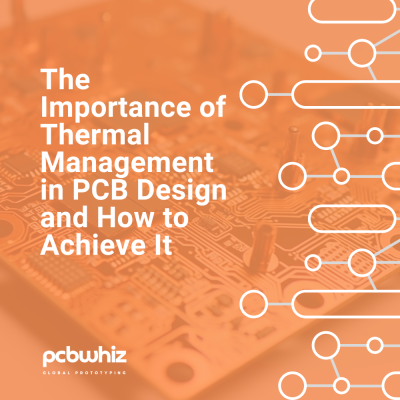The Importance of Thermal Management in PCB Design and How to Achieve It
Martin Huang
Posted on August 4, 2023
Thermal management is a critical aspect of PCB design that is often overlooked but holds immense importance in ensuring the reliable operation and longevity of electronic devices. With the increasing miniaturization and higher power densities of modern electronics, effective thermal management becomes even more crucial. In this article, we will explore the significance of thermal management in PCB design and discuss various techniques and considerations to achieve optimal thermal performance.

1. The Significance of Thermal Management in PCB Design:
1.1. Temperature Effects on Electronic Components:
Excessive heat can have detrimental effects on electronic components, leading to reduced performance, accelerated aging, and even complete failure. Components such as CPUs, power amplifiers, and voltage regulators are particularly susceptible to thermal stress. By implementing effective thermal management techniques, engineers can ensure that components operate within their specified temperature ranges, minimizing the risk of malfunctions or premature failures.
1.2. Impact on Signal Integrity:
Temperature fluctuations can also impact signal integrity in high-speed digital and RF circuits. Heat can cause signal attenuation, impedance variations, and timing issues, leading to data errors, signal degradation, and reduced system reliability. Proper thermal management helps maintain stable operating temperatures, preserving signal integrity and ensuring consistent performance.
1.3. System Reliability and Longevity:
Well-managed heat dissipation improves system reliability and longevity. By keeping components within their optimal temperature ranges, thermal management reduces thermal stress-induced failures, prolongs the lifespan of the PCB and its components, and enhances the overall reliability of the electronic system.
2. Factors Affecting Thermal Performance:
2.1. Component Placement and Layout:
Strategic component placement and optimized PCB layout play a vital role in thermal management. Locating heat-generating components away from sensitive parts and allowing for adequate spacing between components can improve heat dissipation and prevent localized temperature rise. Additionally, optimizing the routing of power and ground planes can help in efficient heat transfer and minimize thermal hotspots.
2.2. Heat Sink Selection and Design:
Heat sinks are commonly used to dissipate excess heat from high-power components. Proper heat sink selection, considering factors such as thermal conductivity, size, and airflow conditions, is crucial for effective thermal management. Additionally, optimizing heat sink attachment methods and thermal interface materials can improve heat transfer efficiency.
2.3. Thermal Vias and Copper Fill:
Thermal vias and copper fill techniques enhance heat dissipation by providing additional pathways for heat transfer. By strategically placing thermal vias beneath heat-generating components or using copper fill in heat sink regions, thermal conductivity can be improved, reducing thermal resistance and promoting efficient heat dissipation.
2.4. Enclosure Design and Ventilation:
The overall system enclosure design plays a significant role in thermal management. Proper ventilation, airflows, and heat dissipation paths within the enclosure can help remove hot air and prevent heat buildup. Design considerations such as the positioning of vents, fans, and heat sinks in relation to the PCB can greatly impact the overall thermal performance of the system.
3. Techniques to Achieve Effective Thermal Management:
3.1. Thermal Analysis and Simulation:
Utilizing thermal analysis and simulation tools early in the design phase enables engineers to identify potential thermal issues and optimize the design accordingly. By simulating temperature distribution and heat flow, designers can make informed decisions regarding component placement, copper fill, and other thermal management techniques.
3.2. Proper Selection of PCB Materials:
Choosing PCB materials with good thermal conductivity and low thermal resistance can significantly improve heat dissipation. Materials such as metal core PCBs or high-thermal-conductivity laminates can effectively spread heat and reduce temperature differentials across the board.
3.3. Thermal Relief Pads and Traces:
Thermal relief pads and traces are used in PCB designs to minimize the impact of thermal expansion and improve solderability. These structures prevent excessive heat transfer to sensitive components and help maintain consistent electrical connections.
3.4. Active Cooling Methods:
In cases where passive cooling is not sufficient, active cooling methods such as fans, heat pipes, or liquid cooling systems can be employed. These techniques actively remove heat from critical components or the entire system, providing enhanced thermal management capabilities.
Conclusion
Thermal management is a vital consideration in PCB design to ensure the reliable operation and longevity of electronic devices. By understanding the impact of excessive heat on components, signal integrity, and system reliability, engineers can implement effective thermal management strategies. Through careful component placement, optimized layout, heat sink design, thermal vias, enclosure considerations, and the use of analysis tools, engineers can achieve optimal thermal performance. By prioritizing thermal management in PCB design, electronic systems can operate within safe temperature ranges, maintain signal integrity, and deliver enhanced reliability in various applications.
Keep Reading...

A Beginner’s Guide to Understanding PCB Assembly Processes
Die Leiterplattenbestückung (Printed Circuit Board Assembly, PCBA) ist eine entscheidende

How to Upload Your BOM Using the BOM Importer
Richtlinien für das Format Ihrer Stückliste (BOM) Unterstützte Dateiformate Sie

Unleashing Efficiency: How PCB Optimization Transforms Energy Use
In einer Welt, in der Energieeinsparung und Nachhaltigkeit von größter



